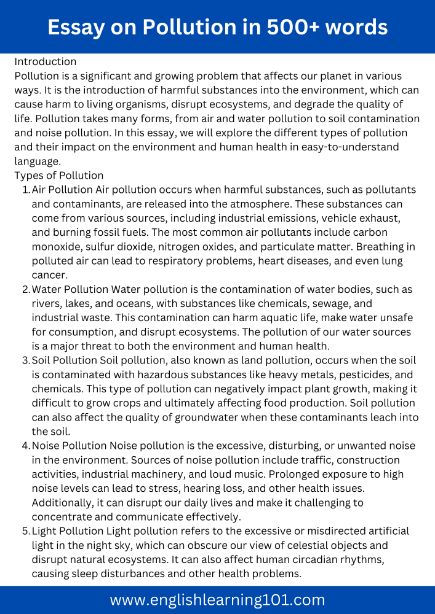Essay on Pollution in English

Introduction
Pollution is a significant and growing problem that affects our planet in various ways. It is the introduction of harmful substances into the environment, which can cause harm to living organisms, disrupt ecosystems, and degrade the quality of life. Pollution takes many forms, from air and water pollution to soil contamination and noise pollution. In this essay, we will explore the different types of pollution and their impact on the environment and human health in easy-to-understand language.
Types of Pollution
- Air Pollution Air pollution occurs when harmful substances, such as pollutants and contaminants, are released into the atmosphere. These substances can come from various sources, including industrial emissions, vehicle exhaust, and burning fossil fuels. The most common air pollutants include carbon monoxide, sulfur dioxide, nitrogen oxides, and particulate matter. Breathing in polluted air can lead to respiratory problems, heart diseases, and even lung cancer.
- Water Pollution Water pollution is the contamination of water bodies, such as rivers, lakes, and oceans, with substances like chemicals, sewage, and industrial waste. This contamination can harm aquatic life, make water unsafe for consumption, and disrupt ecosystems. The pollution of our water sources is a major threat to both the environment and human health.
- Soil Pollution Soil pollution, also known as land pollution, occurs when the soil is contaminated with hazardous substances like heavy metals, pesticides, and chemicals. This type of pollution can negatively impact plant growth, making it difficult to grow crops and ultimately affecting food production. Soil pollution can also affect the quality of groundwater when these contaminants leach into the soil.
- Noise Pollution Noise pollution is the excessive, disturbing, or unwanted noise in the environment. Sources of noise pollution include traffic, construction activities, industrial machinery, and loud music. Prolonged exposure to high noise levels can lead to stress, hearing loss, and other health issues. Additionally, it can disrupt our daily lives and make it challenging to concentrate and communicate effectively.
- Light Pollution Light pollution refers to the excessive or misdirected artificial light in the night sky, which can obscure our view of celestial objects and disrupt natural ecosystems. It can also affect human circadian rhythms, causing sleep disturbances and other health problems.
Impact of Pollution
- Environmental Impact Pollution has far-reaching consequences on the environment. It can lead to the extinction of plant and animal species, disrupt ecosystems, and damage natural habitats. Water pollution, for example, can kill aquatic life and disrupt the balance of aquatic ecosystems. Similarly, air pollution can damage forests, harm wildlife, and contribute to global warming.
- Human Health Pollution is a major threat to human health. Breathing in polluted air can lead to respiratory diseases such as asthma, bronchitis, and lung cancer. Consuming contaminated water can cause waterborne diseases, including cholera and dysentery. Exposure to soil pollution can result in the ingestion of harmful chemicals, affecting human health and food safety. Noise pollution can lead to stress-related illnesses and sleep disturbances.
- Economic Consequences Pollution has significant economic costs. The damage caused by pollution can result in increased healthcare expenses, reduced agricultural productivity, and decreased property values in polluted areas. Furthermore, pollution-related accidents and disasters can lead to large financial losses.
Preventing and Mitigating Pollution
Preventing and mitigating pollution is essential for the well-being of our planet and its inhabitants. Here are some simple ways individuals, communities, and governments can help combat pollution:
- Reduce, Reuse, Recycle: Practicing the three Rs can reduce waste and limit the amount of pollution created by the production and disposal of goods.
- Conserve Energy: Reducing energy consumption can decrease air pollution by reducing the burning of fossil fuels. This can be achieved through energy-efficient appliances and transportation choices.
- Use Environmentally Friendly Products: Opt for products that are eco-friendly and have less impact on the environment.
- Support Renewable Energy: Encourage the use of renewable energy sources like solar and wind power, which are cleaner and more sustainable.
- Proper Waste Disposal: Dispose of waste materials, especially hazardous waste, properly to prevent soil and water pollution.
- Green Transportation: Use public transportation, carpool, or opt for electric vehicles to reduce air pollution from traditional gasoline-powered cars.
- Plant Trees: Trees help absorb carbon dioxide and other pollutants from the air, making them an effective tool in reducing air pollution.
- Raise Awareness: Educate yourself and others about the importance of pollution prevention and sustainable practices.
- Advocate for Change: Support policies and regulations aimed at reducing pollution on a local, national, and global scale.
Conclusion
Pollution is a grave threat to our planet, its ecosystems, and human health. Understanding the various types of pollution and their impact on the environment is the first step toward finding solutions to this critical issue. By taking individual and collective action to reduce pollution and advocating for sustainable practices, we can work together to create a cleaner and healthier world for future generations. It’s essential to remember that every small effort counts, and together, we can make a significant difference in the fight against pollution.
